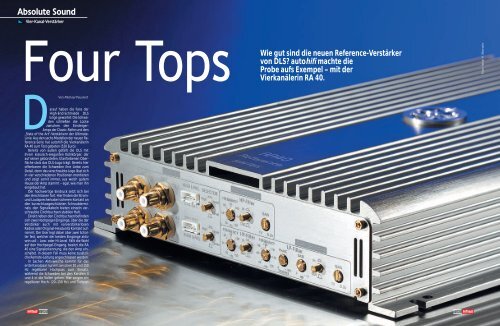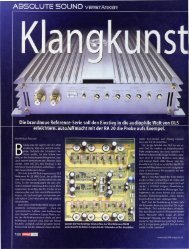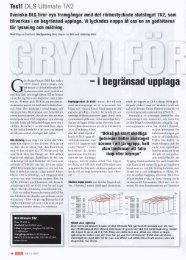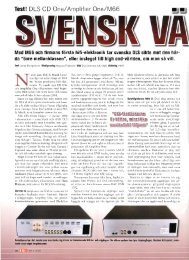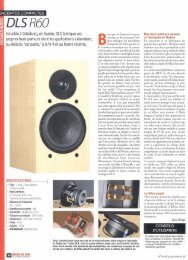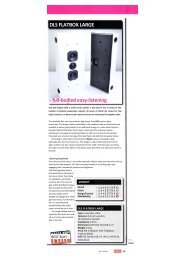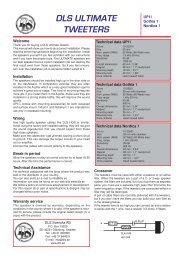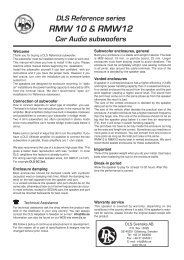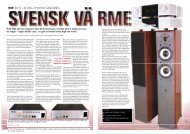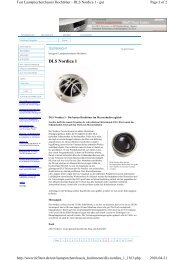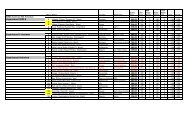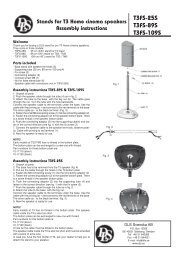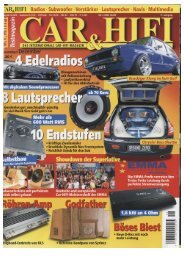Absolute Sound - DLS
Absolute Sound - DLS
Absolute Sound - DLS
You also want an ePaper? Increase the reach of your titles
YUMPU automatically turns print PDFs into web optimized ePapers that Google loves.
<strong>Absolute</strong> <strong>Sound</strong><br />
Vier-Kanal-Verstärker<br />
Four Tops<br />
D<br />
3/2005<br />
Von Michael Peuckert<br />
arauf haben die Fans der<br />
High-End-Schmiede <strong>DLS</strong><br />
lange gewartet: Die Schweden<br />
schließen die Lücke<br />
zwischen den Einsteiger-<br />
Amps der Classic-Reihe und den<br />
„State of the Art“-Verstärkern der Ultimate-<br />
Linie. Aus den sechs Modellen der neuen Reference-Serie<br />
hat autohifi die Vierkanälerin<br />
RA 40 zum Test gebeten (520 Euro).<br />
Bereits von außen gefällt die <strong>DLS</strong> mit<br />
ihrem klassisch-eleganten Kühlkörper, der<br />
auf seiner gebürsteten, titanfarbenen Oberfläche<br />
stolz das <strong>DLS</strong>-Logo trägt. Bereits hier<br />
offenbaren die Schweden ihre Liebe zum<br />
Detail, denn das verschraubte Logo lässt sich<br />
in vier verschiedenen Positionen montieren<br />
und zeigt somit immer, aus welch gutem<br />
Hause der Amp stammt – egal, wie man ihn<br />
eingebaut hat.<br />
Der hochwertige Eindruck setzt sich bei<br />
den Anschlüssen fort. Hier finden die Stromund<br />
Lautsprecherkabel sicheren Kontakt an<br />
den kurzschlussgeschützten Schraubterminals;<br />
den Signalkabeln bieten einzeln verschraubte<br />
Cinchbuchsen stabilen Halt.<br />
Direkt neben den Cinchbuchsen befinden<br />
sich zwei Hochpegel-Eingänge, über die der<br />
Verstärker auch mit vorverstärkerlosen<br />
Radios oder Original-Headunits Kontakt aufnimmt.<br />
Der User legt dabei über zwei Schalter<br />
fest, welcher der beiden Eingänge aktiv<br />
sein soll – Low- oder Hi-Level. Fällt die Wahl<br />
auf den Hochpegel-Eingang, besitzt die RA<br />
40 eine Signalerkennung, die den Amp einschaltet.<br />
In diesem Fall muss keine zusätzliche<br />
Remote-Leitung angeschlossen werden.<br />
In Sachen Aktivweiche kommt für das<br />
erste Kanalpaar nur ein zwischen 20 und 150<br />
Hz regelbarer Hochpass zum Einsatz,<br />
während die Schweden bei den Kanälen 3<br />
und 4 in die Vollen gehen. Hier sorgen ein<br />
regelbarer Hoch- (20–150 Hz) und Tiefpass<br />
Wie gut sind die neuen Reference-Verstärker<br />
von <strong>DLS</strong>? autohifi machte die<br />
Probe aufs Exempel – mit der<br />
Vierkanälerin RA 40.<br />
3/2005<br />
Fotos: Fabian H. Silberzahn
<strong>Absolute</strong> <strong>Sound</strong><br />
Vier-Kanal-Verstärker<br />
(40–125 Hz) für die Frequenzaufteilung.<br />
Beide Filter können auch kombiniert werden<br />
und fungieren dann als Bandpass,<br />
um etwa Kickbässe anzutreiben. Ergänzt<br />
werden die Filter von einem Phaseshift<br />
und einem regelbaren Bass-Boost.<br />
Der Blick ins Innere der eleganten<br />
Schwedin entlockt Technikfreaks ein<br />
freudiges Lächeln, denn die Reference<br />
RA 40 trägt die guten Gene der genialen<br />
<strong>DLS</strong>-Ultimate-Endstufen offen zur Schau.<br />
So tummeln sich im Single-Netzteil jede<br />
Menge hochwertiger Kondensatoren mit<br />
einem besonders niedrigen Innenwiderstand,<br />
während in der Vorstufensektion<br />
feine Folienkondensatoren ihren<br />
Dienst verrichten.<br />
Gekapselte Schalter, deren mechanisches<br />
Klicken eine wahrer Ohrenschmaus<br />
ist, und Potenziometer unterstreichen<br />
gekonnt den High-End-Appeal<br />
der Endstufe. Ebenso wie die doppelt<br />
kaschierte und mit reichlich SMD-Bauteilen<br />
bestückte Platine, auf der sich<br />
16 Endtransistoren um die Leistungsgewinnung<br />
kümmern.<br />
Im Messlabor zeigte die <strong>DLS</strong> dann ihre<br />
ganze Kraft und lieferte an 4 Ohm gute<br />
4x77 Watt ab. Auch die 4 x 122 Watt an<br />
2Ohm können sich sehen lassen, ebenso<br />
wie der niedrige Klirrfaktor von 0,013<br />
Prozent und der Dämpfungsfaktor von<br />
über 330 im Bassbereich.<br />
Die Stunde der Wahrheit schlug dann<br />
jedoch im Hörraum. Gefüttert mit CD-<br />
Kost von Tracy Chapman und Sting bot<br />
die <strong>DLS</strong> eine neutrale Spielweise, die mit<br />
einem feinen Hochtonbereich ausgestattet<br />
daherkam. Im direkten Vergleich<br />
mit der Referenz-Endstufe Helix B 4 Precision<br />
wirkten die Höhen sogar noch einen<br />
Tick glänzender.<br />
3/2005<br />
Dass sich die RA 40 aber nicht nur mit<br />
audiophilen Aufnahmen wohlfühlte,<br />
zeigte sie dann beim Hip-Hop-Kracher<br />
„In da Club“ von 50 Cent. Hier legte die<br />
Schwedin eine straffe und sehr dynamische<br />
Spielweise im Bassbereich aufs Parkett<br />
und scheute auch nicht davor<br />
zurück, in den Tiefbasskeller hinabzusteigen.<br />
Allerdings wirkte die Performance<br />
der Helix hier noch schwärzer, was letztlich<br />
zu einem Patt mit dem Referenz-<br />
Amp in der Kategorie Klang sorgte.<br />
Fazit: Satte Power, satter Klang – der<br />
Einstand der <strong>DLS</strong>-Reference-Serie ist<br />
mit der RA 40 rundum gelungen. �<br />
Praxisgerecht:<br />
Die <strong>DLS</strong> bietet<br />
einen Phaseshift<br />
für den Sub<br />
(oben) und eine<br />
Auto-Start-Funktion<br />
bei Verwendung<br />
des Hochpegel-Ins<br />
(unten).<br />
Hochwertig: Der<br />
Innenaufbau<br />
gefällt mit SMD-<br />
Technik und<br />
guten Bauteilen.<br />
<strong>DLS</strong> Reference RA 40<br />
Preis: 520 Euro<br />
Vertrieb: <strong>DLS</strong><br />
Hohenzollernstraße 11–13, 40211 Düsseldorf<br />
www.dlsmobil.de<br />
autohifi-Messwerte<br />
Ausgangsleistung (13,8 V, 1% Klirr)<br />
4 x 77 Watt an 4 Ω (35 A)<br />
4 x 122 Watt an 2 Ω (61 A)<br />
2 x 68 + 1 x 266 Watt an 4 Ω (48 A)<br />
Klirrfaktor (P/2 an 4 Ω) 0,013 %<br />
Klirrfaktor (5 W an 4 Ω) 0,022 %<br />
Rauschabstand 89 dB<br />
Dämpfungsfaktor<br />
10 kHz/100 Hz 217/334<br />
50 Hz/30 Hz 334/334<br />
Wirkungsgrad (Pmax) 58,0 %<br />
Wirkungsgrad (P/2 an 4 Ω) 44,6 %<br />
Stabilität ( 4 Ω / 2 Ω) 58,4 %<br />
Maße (B x H x T) 359 x 59 x 245 mm<br />
Frequenzgänge<br />
<strong>DLS</strong> Reference RA 40 autohifi-Testlabor<br />
6dB<br />
3dB<br />
0dB<br />
-3dB<br />
-6dB<br />
-9dB<br />
-12dB<br />
10Hz 100Hz 1kHz 10kHz 100kHz<br />
Etwas breitbandig arbeitender Bass-Boost<br />
(grün), deutliche Pegelerhöhung bei aktiviertem<br />
Tiefpass (blau).<br />
Klirrspektrum<br />
<strong>DLS</strong> Reference RA 40 autohifi-Testlabor<br />
-30dB<br />
-50dB<br />
-70dB<br />
-90dB<br />
-110dB<br />
-130dB<br />
-150dB<br />
20Hz 200Hz 2kHz 20kHz<br />
Niedriges Grundrauschen, ansonsten recht harmonisch<br />
abfallendes Klirrspektrum.<br />
Ausstattung: 2 x Hoch- (20-150 Hz) und 1 x<br />
Tiefpass (40–125 Hz), Bandpass (Kanal 3 +<br />
4), Phase-Shift (0–180 Grad), Bass-Boost<br />
(0–18 dB, 40 Hz), Hochpegel-Eingang.<br />
autohifi-Bewertung (max. 100 Punkte)<br />
Klang (30) Punkte<br />
���������� 24<br />
Leistung (30)<br />
���������� 15<br />
Verarbeitung (20)<br />
���������� 14<br />
Ausstattung (20)<br />
���������� 9<br />
TESTURTEIL<br />
62<br />
Punkte Punkte<br />
Spitzenklasse<br />
Bewertung Spitzenklasse<br />
Preis/Leistung<br />
www.autohifi-magazin.de
<strong>Absolute</strong> <strong>Sound</strong><br />
Four channel amplifier<br />
Four Tops<br />
How good are the new reference amplifiers from <strong>DLS</strong>? autohifi puts<br />
them to the test – with the four channel RA 40.<br />
By Michael Peuckert<br />
This is what the fans of the high end forge <strong>DLS</strong> have long been waiting for: the Swedes are<br />
closing the gap between beginner amps from the classic range and the “state of the art” amplifiers<br />
from the ultimate product lines. Of the six models from the new reference series, autohifi had the<br />
pleasure of testing the four channel RA 40 (520 Euros).<br />
The <strong>DLS</strong> is immediately pleasing from the outside with its classically elegant cooling<br />
element, which proudly bears the <strong>DLS</strong> logo on its brushed titanium coloured surface. The Swedes<br />
already demonstrate their love of detail here – the screwed logo can be mounted in four different<br />
positions, ensuring that the good name of its manufacturer can always be seen, regardless how it<br />
has been installed.<br />
The high quality impression is followed though with the connectors. The power and speaker<br />
cables find secure contact to the short circuit protected screw terminal; the signal cables provide<br />
individually screwed cinch sockets with a stable hold.<br />
Directly next to the cinch sockets are two high level inputs via which the amplifier can even<br />
connect to radios without pre-amps or original head units. Using two switches, the user determines<br />
which of the two inputs are to be active – low or high level. If the choice is made in favour of the<br />
high level input, the RA 40 has a signal recognition which switches on the amp. In this case, no<br />
additional remote lines need to be connected.<br />
When it comes to active frequency crossover, there is only one high pass filter adjustable<br />
between 20 and 150 Hz to use for the first pair of channels, while the Swedes go to the max with<br />
channels 3 and 4. An adjustable high and (20–150 Hz) and low pass filter (40–125 Hz) takes care<br />
of the frequency division. Both filters can also be combined and act then as a band pass, driving<br />
any kicking bass. The filters are augmented by a phase shift and an adjustable bass boost.<br />
A look at the insides of the elegant Swede will bring an expression of sheer delight to the<br />
faces of techno freaks as the Reference RA 40 openly bears all the good genes of the brilliant <strong>DLS</strong><br />
Ultimate power amplifier. A whole bunch of high quality capacitors with extremely low internal<br />
resistance cavort in the single power pack while in the preamp section fine foil capacitors do their<br />
thing.<br />
Insulated switches whose mechanical clicking is a true feast for the ears coupled with a<br />
potentiometer masterfully highlight the high end appeal of the power amplifier. The same goes for<br />
the double sided printed circuit board which is richly covered in SMD components as well as 16<br />
output transistors which take care of the output power.<br />
In the measuring lab, the <strong>DLS</strong> showed its full power and at 4 Ohm it delivered 4 x 77 Watt.<br />
Even the 4 x 122 Watt at 2 Ohm needn’t be ashamed of its performance and the same goes for the<br />
low distortion factor of 0.013 per cent and the damping factor of over 330 in the bass end.<br />
However, the hour of truth struck in the listening room. Fed with CD delights from Tracy<br />
Chapman and Sting, the <strong>DLS</strong> put on a neutral play which was accompanied by a fine high tone<br />
range. In direct comparison with the Helix B 4 Precision reference power amplifier, the high tones<br />
even sounded a touch more brilliant.<br />
That the RA 40 feels at home not only with audiophile recordings is demonstrated with the<br />
Hip-Hop stormer “In da Club” by 50 Cent. Here the Swede delivered a tight and very dynamic<br />
playing style in the bass range and was not afraid of going down to the very depths of the deep<br />
bass range. Nevertheless, the Helix gave an even darker performance which in the end led to a<br />
stalemate with the reference amp in the sound category.<br />
Summary: full power, full sound – the RA 40 makes a successful debut for the <strong>DLS</strong><br />
Reference series.
For practical use:<br />
The <strong>DLS</strong> provides a phase shift for the sub (above) and an auto start function when using<br />
the high level inputs (below).<br />
High quality: The inside design is a sheer pleasure with its SMD technology and good<br />
components.<br />
<strong>DLS</strong> Reference RA 40<br />
Price: 520 Euros<br />
Marketed by: <strong>DLS</strong><br />
Hohenzollernstraße 11–13, 40211 Düsseldorf<br />
www.dlsmobil.de<br />
autohifi measured values<br />
Output rating (13.8 V, 1% distortion)<br />
4 x 77 Watt at 4 Ohm (35A)<br />
4 x 122 Watt at 2 Ohm (61A)<br />
2 x 68 + 1 x 266 Watt at 4 Ohm (48A)<br />
Distortion factor (P/2 at 4 Ω)<br />
Distortion factor (5 W at 4 Ω)<br />
Signal to noise ratio 89 dB<br />
Damping factor<br />
Efficiency (Pmax)<br />
Efficiency (P/2 at 4Ohm)<br />
Stability<br />
Dimensions (W x H x D)<br />
Frequency response<br />
Fairly wide band working bass boost<br />
(green), significant level increase with activated<br />
low pass filter (blue).<br />
autohifi Test Lab<br />
Distortion spectrum<br />
Low background noise, otherwise really harmonic<br />
ranging harmonic distortion spectrum.<br />
autohifi Test Lab<br />
Equipment: 2 x high pass (20-150 Hz) and 1 x<br />
Low pass (40–125 Hz), band pass (canal 3 +<br />
4), phase shift (0–180 degree), bass boost<br />
(0–18 dB, 40 Hz), harmonic distortion input.<br />
autohifi rating (max. 100 points)<br />
<strong>Sound</strong> Points<br />
Performance<br />
Processing<br />
Equipment<br />
autohifi TEST RESULT<br />
Top Class 62 Points<br />
Price / performance


